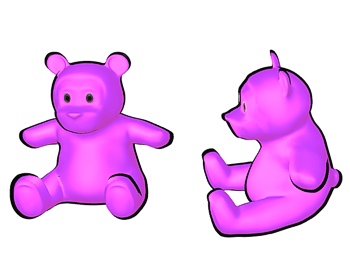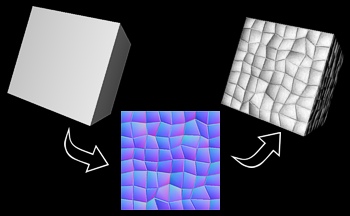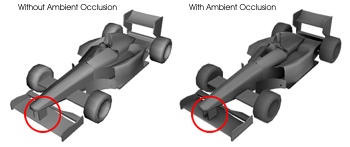Posts Tagged ‘rendering’
Wednesday, May 7th, 2008
Here’s a fun one! Ever wanted to re-create the look of heavy “toon” outlines, but didn’t have a shader for it? Believe it or not, there’s an easy way to fake it using fixed-function only.

Here’s how to do it:
- Make sure all your surface normals are unified (facing outwards) and your polygons are set to 1-sided
- Make a copy of your object and resize it so it is ever-so-slightly larger than the original
- On the copy, set the surface material to black
- Invert the surface normals
That’s it! Nifty, eh? The method’s not perfect–for best results, stick to convex objects–but it’s great for quick renders and on limited hardware platforms where shaders aren’t an option.
Tags: ac3d, cg, cgi, computer graphics, hacks, non-photorealistic rendering, raytracing, rendering, toon shading, tricks
Posted in 3D Tutorials, General | Comments Off on Fake Toon Outlines
Friday, January 25th, 2008
POV-Ray has some very powerful commands for rendering realistic plasmas and explosions, but not very many people know how to use them well. This tutorial will show you how.
[youtube:http://www.youtube.com/watch?v=CbxqIwk8-e0 350 292]
An turntable of a plasma cloud rendered in POV-Ray
UPDATE:
download the high-res version
(more…)
Tags: cg, cgi, clouds, computer graphics, explosions, fog, media, particles, plasma, POV-Ray, render, rendering
Posted in 3D Tutorials, General | 6 Comments »
Saturday, December 8th, 2007
This plugin exports your AC3D file into NMF format, the native input format of the ATI NormalMapper utility. NormalMapper allows you to generate normal maps, bent normals and ambient occlusion maps suitable for use in video games and other realtime 3D applications.
If you aren’t familiar with normal maps, normal maps are a way to make your low-polygon model look more detailed by encoding surface information from a high-polygon version of the same model into a texture map. Ben Cloward has an excellent tutorial where you can learn more.
This plug-in requires the free NormalMapper utility available from AMD in order to process the output files. The companion NormalMapperUI (Stand Alone) available at the same location is also helpful, but not required.
Download the plugin. (Requires Windows XP, AC3D 6.2 or above.)

Tags: ac3d, ambient occlusion, ati, bump mapping, cg, cgi, computer games, computer graphics, melody, normal mapping, normalmapper, parallax mapping, realtime 3d, realtime rendering, rendering, video games
Posted in General, Tools and Plugins | 2 Comments »
Tuesday, November 27th, 2007
Ambient occlusion is a lighting technique that is commonly used to create soft shadows on objects. Ambient occlusion isn’t used to create the type of shadows that are cast from objects with a light shining directly on them. Instead, ambient occlusion generates the type of deep shadows that appear in the corners or creases of things, where it is hard for the light to reach.
Technically speaking, ambient occlusion is a global illumination technique. However, in common usage of the term it is often referred to as a cheap alternative to global illumination. To clear up any confusion, what most renderers refer to as “global illumination” is actually an amalgamation of several techniques such as radiosity, metropolis light transport, image-based lighting or photon mapping. The actual techniques used differ slightly from renderer to renderer. Some renderers include an ambient occlusion term as part of their global illumination calculation; others do not.
Like most global illumination techniques, ambient occlusion is dependent on the other geometry in the scene. Ambient occlusion on its own generates less realistic lighting than “full” global illumination. However, ambient occlusion is much faster and less complex to calculate than other methods which is why it is still popular among game developers and in production animation.

(Left) Without Ambient Occlusion. (Right) With Ambient Occlusion
Click for larger image.
(more…)
Tags: 3d, 3d graphics, ambient occlusion, cg, cgi, global illumination, graphics, monte carlo, programming, ray casting, ray tracing, rendering, ssao
Posted in 3D Tutorials, Code Snippets, General | 9 Comments »
Wednesday, October 17th, 2007
So you’ve created your 3D model… now what? Many 3D design programs have their own renderer built in, but some don’t. You may need an external program to create images. In other cases, the software may include its own renderer, but it may not have all of the features that a stand-alone renderer provides.
If you’ve never tried a stand-alone renderer before and want to try one, here is a list of well-known stand-alone 3D rendering programs that are available from their creators free-of-charge:
(more…)
Tags: 3d, 3delight, aqsis, free renderer, gelato, kerkythea, megapov, nvidia, pixie, povray, renderer, rendering, stand alone renderer, sunflow
Posted in 3D Tutorials, General | 6 Comments »


